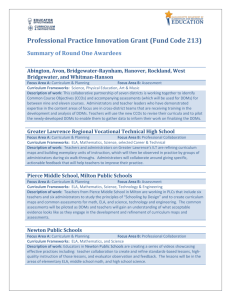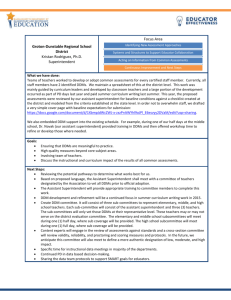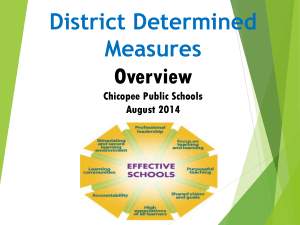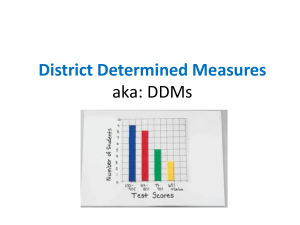Educator Evaluation and Professional Development
advertisement
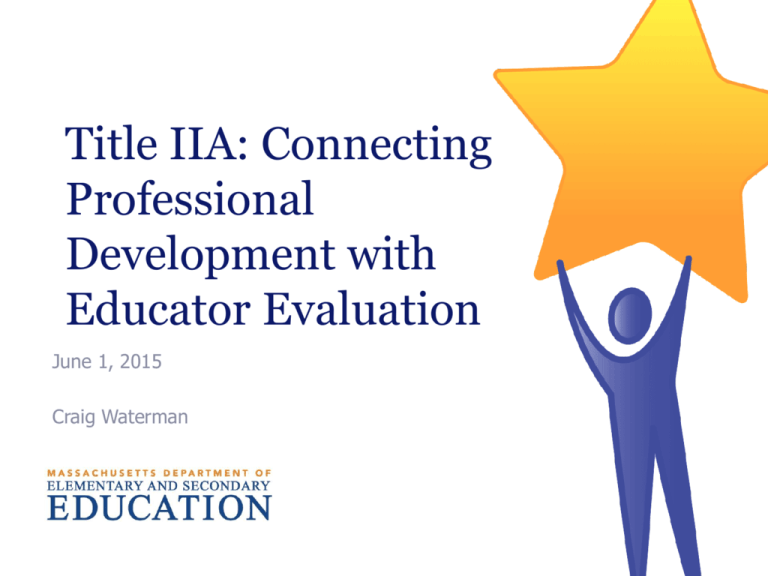
Title IIA: Connecting Professional Development with Educator Evaluation June 1, 2015 Craig Waterman Overview of the Educator Evaluation Framework Two Separate Ratings Student Impact Rating Summative Performance Rating Rating of Practice Exemplary Proficient Needs Improvement Unsatisfactory Rating of Impact High Moderate Low Sources of Evidence Student Impact Rating Summative Performance Rating Evidence of Practice Observations Artifacts Student/ Staff Feedback Professional Practice Goals Student Learning Goals Evidence of Outcomes Median Student Growth Percentiles (were applicable) Common Measures of Student Achievement, Growth , and Learning (DDMs) Summative Performance Rating Student Impact Rating Summative Rating The Educator Evaluation Framework Exemplary Proficient 1-yr Self-Directed Self-Directed 2-yr Self-Directed Growth Plan Growth Plan Growth Plan Needs Improvement Directed Growth Plan Unsatisfactory Improvement Plan Low Moderate High Rating of Impact on Student Learning Overview of Student Impact Rating Student Impact Rating Student Impact Rating Evaluators assign a rating of “high,” “moderate,” or “low” based on trends (at least 2 years) and patterns (at least 2 measures) Based on Common Measures Student Growth Percentiles (SGPs) District-Determined Measures (DDMs) Definition of DDM “Measures of student learning, growth, and achievement related to the Massachusetts Curriculum Frameworks, Massachusetts Vocational Technical Education Frameworks, or other relevant frameworks, that are comparable across grade or subject level districtwide. These measures may include, but shall not be limited to: portfolios, approved commercial assessments and district-developed pre and post unit and course assessments, and capstone projects.” Student Measures Aligned to Frameworks 603 CMR 35.02 Comparable Across District Expansive Definition of Acceptable Measures Student Impact Rating Implementation Status Major Areas of Work Identification & Development Administration Protocols Setting Parameters Managing and Using Data Districts are asked to report progress in each area based on the categories: No plan in place, plan in place, in progress, nearly completed, completed. Major Areas of Work (Completed) Identification of Measures Administration Protocols Parameters Data Management ELA 53% 30% 18% 18% MATH 53% 23% 18% 18% SS/History 41% 18% 12% 12% Science/Tech 47% 23% 18% 18% Languages/ ESL 39% 18% 12% 12% Health/ PE 53% 18% 18% 18% Arts 47% 18% 19% 24% CVTE 50% 25% 25% 50% SISPs 41% 17% 17% 23% Admin 41% 17% 12% 23% Based on 17 district responses as of May 22, 2015 Major Areas of Work (No Plan) Identification of Measures Administration Protocols Parameters Data Management ELA 0% 6% 24% 30% MATH 0% 6% 24% 30% SS/History 12% 12% 30% 35% Science/Tech 6% 6% 23% 30% Languages/ ESL 0% 0% 18% 29% Health/ PE 12% 12% 24% 41% Arts 18% 18% 25% 41% CVTE 50% 50% 50% 50% SISPs 24% 24% 35% 41% Admin 18% 18% 35% 35% Based on 17 district responses as of May 22, 2015 SRI Statewide Survey Results Sample Completed February – March 2015 67 Schools from 20 districts 44 Principals 564 school staff Challenges Readiness to implement Meaningful Development Buy-in Understanding the System Using Results Readiness to Implement Districts are still preparing to administer DDMs 40% of principals feel they prepared to administer DDMs or use systems to store DDM data 70% of school staff believe the DDM(s) for their grade/subject are well-aligned to the content they are teaching 64% of school staff feel they have sufficient understanding on how to administer the DDMs assigned to their grade/subject (Percent agree or strongly agree) Meaningful Development Educators need additional support to develop meaningful DDMs DDMs identification and development has supported meaningful conversations among educators about curriculum (48% and 42%) DDMs identification and development has supported improved assessment literacy (40% and 31%) DDMs identification and development has been a meaningful experience for educators (38% and 22%) (Percent agree or strongly agree for Principals & School Staff) Buy-in Perceptions about the value of DDMs are mixed. 41% of principals and 39% of school staff believe DDMs in general will help improve student learning, growth, and achievement 49% of principals and 38% of school staff DDMS are a valuable component of a robust educator evaluation system 55% of principals and 30% of school staff Including Student Impact Ratings in the evaluation system is fair (Percent agree or strongly agree) Understanding the System There is still a lack of understanding about how DDMs are used in the Educator Evaluation system 74% of principals and 46% of school staff understand how DDMs will be used as part of the educator evaluation system 55% of principals and 63% of school staff feel anxious about how Student Impact Ratings will affect their job security (Percent agree or strongly agree for Principals & School Staff) Using Results Districts are unsure how they will effectively use results from DDMs 70% of principals and 50% of school staff understand how the information from their DDM(s) will inform their practice 66% of principals believe their DDMs will improve their knowledge about the progress of students in their school 57% of principals believe that data from their DDMs will help them make decisions about how to support students’ learning in their school (Percent agree or strongly agree) ESE Response Additional Time for districts that need it Options for districts to request alternative approaches to determining a Student Impact Rating Continued support Highlighting effective district practices Additional resources for Special Education educators More example DDMs Using Professional Development to support the Student Impact Rating Critical Skills: Over Time Early Implementation Formal Evaluation Using Results to inform Practice Assessment Literacy Continued Improvement Formal Evaluation Content Alignment Content Alignment Assessment Literacy Using Results to inform Practice Content Alignment: Goals Curriculum Frameworks Greater Understanding (e.g. Massachusetts Frameworks, Proposed Science Standards, or National Standards for World Languages) Curriculum Development, Alignment, and Review. Teaching Strategies Determining Core Course Objectives Identification of CCOs (e.g. Importance, New Shifts, Challenging for students, or District Priorities.) Coherence across grade and content Content Alignment: Examples Curriculum Frameworks Optional, after school study group, focused on understanding the concept of proficiency from the National World Languages Standards Professional development workshop around using multiple text sources to support writing (a shift in Massachusetts Frameworks) Determining Core Course Objectives In Worcester, they hired a consult who trained educators in the identification and development of rubrics based on common assessment “verbs”. Assessment Literacy: Goals Understanding Basic Principles of Assessment Concepts (Validity, Error, Bias) Item traits (Difficulty, Cognitive Complexity, Discrimination) Practical Strategies Administration Protocols Supports, Accommodations and Modifications for different groups of students Reviewing Alignment with Content Assessment Literacy: Examples Understanding Basic Principles of Assessment Guest speaker presents examples on the distinction between item difficulty and cognitive complexity Workshop that helps educators apply important assessment concepts when they review currently used assessments. Practical Strategies Consultant shares practices of good assessment administration and works with a team to review their own administration protocols Attend assessment review of existing accommodation practices at an educational collaborative Using Results: Goals Managing and Using Data Improving methods of collecting and storing results Easy access to data Understanding different potential analyses Connecting Results to Practice Creating effective habits Looking at change over time Using Results: Examples Managing and Using Data Cross-site visits with neighboring districts to learn different approaches to storing and managing data Training educators to use resource tools on managing data Connecting Results to Practice Consultant helps educators identify characteristics of students labeled as having demonstrated “low growth” and shares strategies to support these students Formal Evaluation: Goals Understanding how DDMs are used in evaluation Teachers’ central role in leading this work How Summative Rating and Student Impact Rating are combined Priority on formative use Formal Evaluation: Examples Understanding how DDMs are used in evaluation District pays for travel for educators to attend an “office hours” presentation to deepen their understanding of the policy goals and requirements. Resources: http://www.doe.mass.edu/edeval/sir/guidance.html Quick Reference Guides QRG: Student Impact Rating QRG: District-Determined Measures Guidance Documents Implementation Briefs Rating Educator Impact Guidance Additional Resources Model Contract Language Example Assessments Craig Waterman cwaterman@doe.mass.edu 781-338-3244

